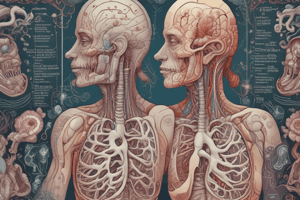Podcast
Questions and Answers
What is the primary function of the respiratory system?
What is the primary function of the respiratory system?
- To filter the air we breathe
- To remove carbon dioxide from the body
- To circulate oxygen to the body
- To provide energy to the body through respiration (correct)
What is the purpose of the nasal cavity?
What is the purpose of the nasal cavity?
- To warm and moisten the air we breathe
- To filter out dust particles and bacteria from the air (correct)
- To expand the lungs
- To provide oxygen to the body
What is the trachea?
What is the trachea?
- A tube that divides into bronchi
- A muscle that helps expand the lungs
- A cluster of air sacs called alveoli
- A thick tube reinforced by rings of cartilage (correct)
What is the function of the bronchioles?
What is the function of the bronchioles?
What is the primary function of the alveoli?
What is the primary function of the alveoli?
What happens when the diaphragm contracts during inhalation?
What happens when the diaphragm contracts during inhalation?
What occurs during gas exchange at the alveoli?
What occurs during gas exchange at the alveoli?
What is the purpose of the capillaries surrounding the alveoli?
What is the purpose of the capillaries surrounding the alveoli?
Flashcards
Respiration
Respiration
The process of taking in oxygen and releasing carbon dioxide, which provides energy to the body.
What is the function of the nasal cavity?
What is the function of the nasal cavity?
To filter out dust and germs from the air we breathe.
What is the trachea?
What is the trachea?
A tough tube that connects the throat to the lungs, reinforced with cartilage rings to keep it open.
What is the function of the bronchioles?
What is the function of the bronchioles?
Signup and view all the flashcards
What is the function of the alveoli?
What is the function of the alveoli?
Signup and view all the flashcards
What happens to the diaphragm during inhalation?
What happens to the diaphragm during inhalation?
Signup and view all the flashcards
What occurs during gas exchange at the alveoli?
What occurs during gas exchange at the alveoli?
Signup and view all the flashcards
What is the purpose of the capillaries surrounding the alveoli?
What is the purpose of the capillaries surrounding the alveoli?
Signup and view all the flashcards
Study Notes
Respiratory System Overview
- The body needs oxygen to produce energy through respiration, and expels carbon dioxide as a byproduct.
- The respiratory system is responsible for breathing in oxygen and breathing out carbon dioxide.
Nasal Cavity
- Most air is inhaled through the nose, with some entering through the mouth.
- The nasal cavity warms, moistens, and cleans the air.
- Large dust particles are trapped by nostril hairs, while finer particles and bacteria are caught by sticky mucus and cilia, which can be swallowed.
Trachea
- The trachea is a thick tube that air passes through.
- It is reinforced by rings of cartilage that prevent it from collapsing.
Bronchi and Bronchioles
- The trachea divides into two bronchi, which then divide into smaller tubes called bronchioles.
- Bronchioles are located inside the lungs.
Alveoli
- Bronchioles end in clusters of air sacs called alveoli.
- There are approximately 600 million microscopic alveoli in the lungs.
- Alveoli provide a large surface area for gas exchange between the lungs and bloodstream.
Breathing In (Inhale)
- Intercostal muscles contract, lifting the ribs upwards and outwards.
- The diaphragm contracts, moving downwards.
- The lungs expand and fill with air, allowing oxygen to enter the bloodstream through diffusion.
Breathing Out (Exhale)
- Intercostal muscles relax, moving the ribs down and inwards.
- The diaphragm relaxes, moving upwards.
- The lungs contract, forcing the air out, and carbon dioxide enters the lungs through diffusion.
Gas Exchange
- The walls of alveoli are one cell thick and surrounded by tiny blood vessels called capillaries.
- Oxygen moves from the alveoli into the capillaries through diffusion.
- Oxygen is carried throughout the body by red blood cells in the bloodstream.
Studying That Suits You
Use AI to generate personalized quizzes and flashcards to suit your learning preferences.




